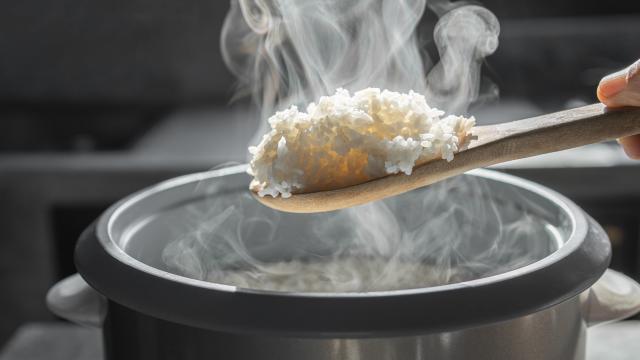I’ve had the same rice cooker since I was in college (and that was not recently). Judge me all you want, but the darn thing cooks rice as perfectly now as it did back when I lived off rice, ramen, and eggs. It’s a budget brand—no Zojirushi, that’s for sure—but that’s just fine. Whether your machine is $US200 with 30 settings, or $US15 with one switch, rice cookers all have the same bones. The best part is that they’re so easy to use, even the least confident cook can feel good about their rice. Here’s how to use a rice cooker for rice—and the many other non-rice foods you can cook in one.
How do rice cookers work?

(Please forgive the appearance of my cooker in the photos; let’s just call it “seasoned,” shall we?)
A rice cooker uses heat and water to cook rice. If you’ve ever cooked rice in a pot on a stove before, you know heat and water aren’t hard to come by. It’s the final stage of not burning the rice that’s tricky. That’s where the rice cooker wins. Unlike your pot on the stove, a rice cooker has a sensor that ensures your grains are cooked to fluffy perfection, and then stops cooking.
Rice cookers have simple mechanics on the inside: a thin metal bowl to hold the rice, a heating plate inside with a spring mechanism underneath, and a thermostat. When you fill the metal bowl with water and rice and load it into the machine, the heating plate conducts easily through the thin metal of the bowl. The temperature only goes up to boiling (212°F) while cooking, because that’s the peak temperature of water before it evaporates.
The steamy air slowly escapes through a hole in the lid or another vent in your rice cooker. This slow ventilation allows condensation to drip back into the rice, extending the boiling time and giving the rice ample time to absorb enough water.
At the end of the cooking time, all of the water has been soaked up or escaped as steam. There is no longer a pool of water in the bowl so the temperature starts to rise above 212°F. This change in temperature triggers the thermostat in the appliance to switch from “cook” over to the “warm” setting, and the spring pushes the bowl up away from the heating plate. The rice is cooked through, with nary a grain burnt.
How to use a rice cooker

1. Rinse your rice
There are many types of rice out there, but I grew up on Jasmine rice, and we always rinsed it. Rinsing it gets rid of excess starch, and this makes sure the finished rice doesn’t end up gloppy. To do this, you can put your measurement of rice in a mesh sieve and run water through it, moving it around with your fingertips. I usually dump the rice into the metal pot and then cover it with water. I swish it around with my fingers and pour off the cloudy water. Usually I do this twice.
2. Add the cooking water
Add the water that you’ll cook the rice in. A 1:2 ratio of rice to water is well-loved. This can change depending on the type of rice you’re using, and how you prefer the final texture to be. If you want drier grains, use a quarter-cup or so less water. If you like wetter rice, use a bit more. If you want super soft rice to break up into congee then you’ll need even more water. Many packages of rice come with suggestions so you can check the directions if you’re unsure.
3. Load up the cooker
Put the metal bowl into the rice cooker and close the lid. Now comes the cooking part where you can press a button and walk away.
Multi-setting models
Cooking with a rice cooker should be a pleasant, simple experience. Even if you have an appliance with a digital screen and multiple settings, there should be a button for “rice.” Some models will have buttons for specific types of rice, like brown rice, sushi rice, or jasmine rice. If you know the type of rice you have, go ahead and select the button. That might be enough, or if there is a “start” button, press it now.
If you don’t know what kind of rice you have, that’s totally fine. Just click “rice” or “white rice.” The amount of water you added is actually more important than the clever little button options they give you. Sure, brown rice and white rice need different timings, but remember what I said about the thermostat? A good machine will be able to adjust the timing based on how much water is left in the tank.
Single-setting models
If you have a rice cooker like I do, you don’t have a lot of options. Simply load the bowl with rice and water, cover it with the lid and press the lever to “cook.” The machine will automatically switch to the warm setting when it’s done.
Highly rated rice cookers:
Use your rice cooker for a whole lot more
Definitely use this handy gadget for perfect rice, but you might as well find it a permanent spot on the counter because it can do so much more. Use it for one-pot meals, hands-off hot oatmeal, perfectly peelable hard-boiled eggs, or mac and cheese that makes itself. I could write a whole entire post on all the things you could make in a rice cooker, but we have that already so just read all about it right here. Have fun exploring, and may your rice cooker steam multiple happy decades of food for you.

Leave a Reply
You must be logged in to post a comment.